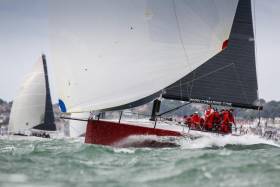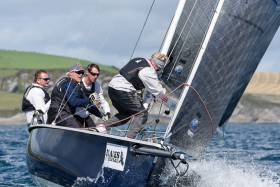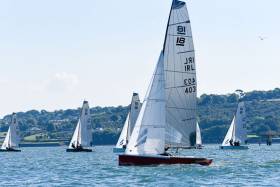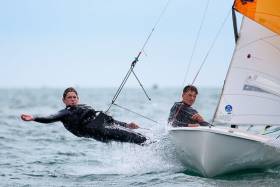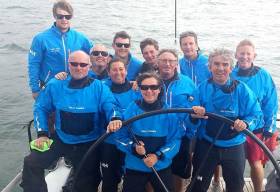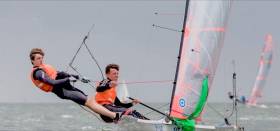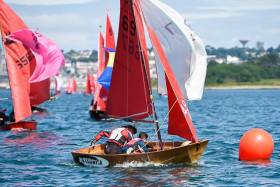Displaying items by tag: Royal Cork Yacht Club
Royal Cork's National 18 Will Be On Display & Racing At Southampton Boat Show 2016
After a successful Irish National Championships this month at Royal Cork Yacht Club, the National 18 Class Association is exhibiting the new Morrison designed National 18 (known as the Ultra) at the Southampton Boat Show from 16 to 25 September 2016.
The National 18 class has undergone a hugely successful period of change and development over the last two years and is now taking a breather and enjoying learning how to get the best out of sailing the fantastic new boats. This means that after two full seasons the boats have been fully tested and developed to meet all the expectations and requirements of the Class members and no more changes are planned in the foreseeable future.
Since the Phil Morrison designed hull was adopted in July 2014, sixteen boats have been built, two more are underway, and a new sail plan has been introduced incorporating a laminate square top mainsail and 21sq m spinnaker, along with twin spinnaker poles. Fifteen Ultras took part in the 2016 National Championship held at Findhorn near Inverness and produced incredibly close and hugely enjoyable racing.
On show at Stand A106 in the Arena will be 'The Shadow' (412) from Blackwater Sailing Club, whilst two National 18s will race in the 'Battle of the Classes' on Sunday 25 September.
The National 18 is available from the Class builder, White Formula of Brightlingsea, at an on-the-water sail away package price of £16,995 including VAT.
The Morrison designed National 18 has, as intended by the Class, created a performance three-person dinghy with one trapeze that is fast and capable of being handled by crews of varying ability, age, and experience; she is not an extreme boat and many people commented that she looks a "proper boat."
The National 18s are renowned for their companionship and great social scene both and on and off the water, as well as for outstanding high performance racing; the Autumn is an ideal time to place an order with the builders to have your new boat ready in good time for next year's racing programme and for the National Eighteen Championships which are to be held at Hayling Island Sailing Club in August 2017.
For further information about the National 18 ClassThe original idea was that of Frank Knowling of Whitstable YC (later to be known as the father of the class) for an 18-foot sailing dinghy, suitable for day sailing, yet fast enough to be of interest to racing sailors and at a reasonable cost. (The first rather hopeful restriction of the original class rules was "Price not to exceed £125 complete with spars, all equipment and designer's fee but not including sails"). The plan was to produce an affordable national alternative to the many local one-designs of about this size to be found right round the coast of the British Isles. Many of these local estuary classes survive today, for example the Mermaid in Dublin, Thames Estuary OD, Chichester Harbour 18 etc.
The well-known designer Uffa Fox won the competition (over the Laurent Giles submitted version) with his 'Ace' design for a clinker-built wooden boat. National 18' number 1, 'Hurricane', was owned by Stanley Beale and sailed at Whitstable, with No.2 'Gust' and No.3 Foam''.
Initial enthusiasm was held back by the effects of World War II but a good deal of 18' building got underway soon afterwards, when mahogany was again available for boat-building and the class became active especially in the Thames Estuary area. By 1950, fleets had appeared at clubs dotted all around the British Isles and Ireland, the Class Association having been formed in 1947.
Although most boats were built to the 'Ace' design, the class had always been 'restricted' rather than 'one-design' and boats with a reduced number of wider planks were built when glued plywood construction was adopted and even one moulded carvel boat was built (252 'Sabon').
Several of the wooden 18's, now called 'Classics' are still in commission, and regularly race, principally at Bosham SC. They include No15 Tinkerbell, built in 1938 and still very competitive.
With the advent of GRP and the rising costs of hard woods, the Class asked Ian Proctor in the late '60's to design a fibreglass hull that would not outclass the existing boats. In this he was successful and it was some time before a Proctor hull won the championships. The first new Proctor, 'Genivieve' was exhibited at the Crystal Palace Dinghy Show of 1970 when a bare hull cost £153. Since then the Class has progressively reduced minimum hull and centreboard weight, and introduced a single trapeze. Also a restriction which requires all new hulls to come from the class mould so they are in effect one-design. Rigs have been optimised and more recently carbon spars introduced.
These changes produced a boat known in the Class as an 'Ultimate' which is fast and exciting to sail and which has provided close and competitive racing for fifteen or so years, both locally and at the annual National Championships. The Royal Cork Yacht Club has the largest fleet.
The class strives to be inclusive in providing heathy competition for all generations of 18s through handicaps and separate starts. Thus though the major trophies at National Championships are awarded in the Ultimate class, there are trophies also for the Pen-ultimates (heavy GRP) and the Classics.
In 2012 the class mould was declared unservicable, and there was much debate about what to do next. This culminated in a request to Phil Morrison to design a hull that was sleeker, lighter, faster and safer, and in so far as reasonably possible within the existing measurement restrictions.
The Morrison prototype was financed by supporters of the Class and built at The Boatyard at Bere in 2013. Named 'Odyssey' and trialled extensively, she ticks all the boxes, is a pleasure to sail and has proved a great success. This development will undoubtedly give the Class a new lease of life, and production of new boats is already under way at White Formula in Brightlingsea.
Royal Cork's Anthony O'Leary to Contest One Ton Cup in Antix
The One Ton Cup owned by the Cercle de la Voile de Paris and presented by Hamble Yacht Services is just a few days away.
As Afloat.ie previously reported, the Cup is considered to be one of the most prestigious trophies in yacht racing. The One Ton Cup dates back to 1899 and was last competed for in 2002. The golden era of the One Ton Cup was when IOR Racing dominated the world of yachting, countries from all over the world competed for the One Ton Cup, where reputations were made and lost. The last winner of the One Ton Cup in the IOR era was Justine, owned by Frank Woods and skippered by Harold Cudmore. Justine won the cup for the Royal Cork Yacht Club in 1981, racing in home waters, the team were unbeaten in every race. The only time that the feat has been achieved before or since.
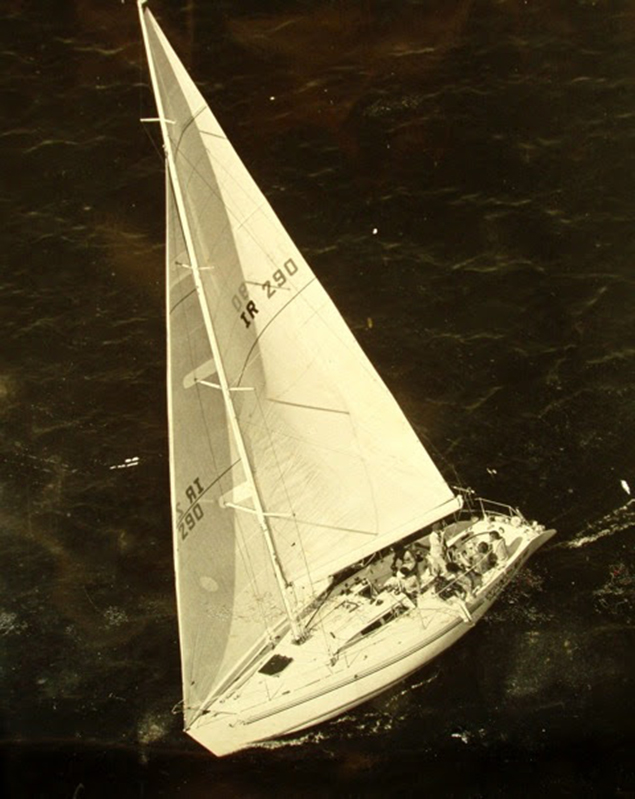 Justine won the cup for the Royal Cork Yacht Club in 1981, racing in home waters, the team were unbeaten in every race. The only time that the feat has been achieved before or since. Photo: John McWilliam
Justine won the cup for the Royal Cork Yacht Club in 1981, racing in home waters, the team were unbeaten in every race. The only time that the feat has been achieved before or since. Photo: John McWilliam
Anthony O'Leary will be racing Ker 40 Antix, this September, flying the burgee of the Royal Cork Yacht Club. “The One Ton Cup is part of yacht racing history and the Royal Cork was immensely proud to host the competition and to have a home win” commented O'Leary. “As always, Antix will be coming to win, we are up against a magnificent fleet of well-sailed boats, and the winners will have to be at the very top of their game. I can't see anyone running away with it.”
Peter Morton's Carkeek 40+ Girls on Film leads the FAST40+ Series, having won the the first three rounds. However, the One Ton Cup counts for double points towards the series, adding even more importance in deciding the season champion. For Peter Morton, winning the One Ton Cup is still a personal ambition.
“So far, we have had good results in most races this season, consistency has been the key.” commented Peter Morton. “ We have a really good team and they all work together well, the communication and the moding of the boat works well and gives everybody confidence. The fleet is definitely compressing, we are all very close, even during long races we are often overlapped after hours of racing. Over the last 30 years I have won the Quarter Ton Cup, the Half Ton Cup and the Three Quarter Ton Cup, on various boats. I have only come second in the One Ton Cup. It is something that is a bit of unfinished business for me, so yes, I would love to win it".
Joining the FAST40+ fleet for the first time at the One Ton Cup, will be Heinz Peter Schmidt's GP42 Silva Neo. The young German team won the German National ORC title four times and won the ORC Euros in 2011, and made the podium for the ORC Worlds in 2014.
The One Ton Cup owned by the Cercle de la Voile de Paris, presented by Hamble Yacht Services and organised by the Royal Southern Yacht Club, will take place between 16-18th September in the Solent, UK. Nine races are scheduled with a mixture of windward-leeward and weighted points factor longer races.
1720 Championship Victory for Peter O'Leary's 'Dutch Gold' in Kinsale
After missing out on Day 2 of the 1720 Irish championship entirely due to inclement weather, OOD Peter Crowley and his team were on the water at Kinsale before 09:00 this morning and managed to complete a full programme of races for the 1720 National Championships writes Peadar Murphy. The wind today was light and shifting, but four highly competitive races were still squeezed in and had everyone ashore just before the rain swept in again.
After the first four races on Friday, Anthony O’Leary on “Antix” led from the Byrne and Wilson outfit on “ZING” and Aoife English on “Atara”. However today, the next generation of O’Learys shot to the fore on “Dutch Gold” (newly arrived from Holland!) with Peter on the helm and Robert midship providing the fleet with a masterclass in 1720 sailing in light airs. Three bullets and a second place finish rightly crowning them as the 1720 National Champions for 2016 and bringing the title to Baltimore Sailing Club, capping off a memorable week for that part of the world!
Though never quite at the front of the fleet today, Padraig Byrne and Don Wilson on “ZING” had done enough on Friday to ensure that their lesser results today still merited a second place overall. The lighter airs today seemed to suit a number of boats that hadn’t been quite in the running in strong stuff on Friday; Fionn Lyden on Baltimore Sailing Club boat “Live Wire” had a strong showing today, and might have been pushed a bit by fellow Baltimore boat “Smile n’ Wave”, though their challenge ran out of steam later in the day. Also prominent today were Paul Gibbons’ “Wahoo” and Dun Laoghaire visitor Kenneth Rumball on “Team INSS”. However, despite an off day today - Anthony O”Leary’s “Antix” came home in third overall with five points to spare over “Wahoo”.
However, the undoubted winner of the Blacks of Kinsale 1720 National Championships was Peter O’Leary.
Irish Sailing Association Seeks Nominees for Junior & All Ireland Sailing Championships
The Irish Sailing Association is inviting class associations to make nominations for the ISA All Ireland Sailing Championship and ISA All Ireland Junior Sailing Championships 2016.
The ISA All Ireland Junior Sailing Championships on September 24th – 25th at Fastnet Marine & Outdoor Education Centre, Schull, Co. Cork. The event will be sailed in FMOEC TR 4.2 class two person dinghies.
The ISA All Ireland Sailing Championship on October 1st – 2nd at Royal Cork Yacht Club, Crosshaven, Co. Cork. The event will be sailed in National 18 three person dinghies.
The ISA is seeking three nominations from each of the senior classes. The junior and youth classes will be advised on the number of places allocated for that class as per notice of race. Nominations will be only accepted from classes whose affiliation fee is paid for 2016.
Class associations are also invited to suggest candidates for a wild card place; these would be members who have excelled at an International competition in the class during the year.
The age limit for the Junior Sailing Championships is under 19 years on December 31, 2016. If a class holds a junior/youth national championship for eligible sailors they may nominate to the Junior championship in the same way and enclosing a copy of the relevant Notice of Race. Please see the Notice of Race for both events below.
The ISA says its policy of a National Race Officer managing racing at a class’s national championship will be strictly applied.
The deadline for nominations is: ISA All Ireland Junior Sailing Championship is 1500hrs on the 12th of September, 2016 and 1500hrs on the 19th of September for the ISA All Ireland Sailing Championships
Royal Cork Yacht Club's 'At Home' Regatta Was One To Remember (Photo Gallery HERE!)
The final day of Royal Cork Yacht Club's 'At Home' was a day to remember writes Bob Bateman. With temperatures in the mid–twenties, there was plenty of activity afloat and ashore. Adults and children alike soaked up the party atmosphere on the club lawn that followed two days of dinghy and keelboat racing on the water.
The cruiser fleet featured racing that included courses from bygone days. Classes one, two and raced out to the Cork buoy while the White Sail fleet took a scenic course around Ringabella Bay.
Rear–Admiral Kieran O’Connell took a hands–on approach to Race Officer duties, alternating between Harmony as starting vessel and a club RIB when he was required to finish the various fleets.
Meanwhile, former Admiral David O’Brien acted as PRO for the Irish National Championships of the National Eighteen class which included nine of the new Ultra designs. On Sunday, sailing in Cork Harbour on the Eastern Bank, the 18s got a much more comfortable day than was experienced on Saturday. Comfortable maybe, but no less competitive, it’s a fleet in which no quarter is expected or given on the water. The three–man dinghy fleet got in three good races in the north westerly wind. Nobody could match Ewen Barry, Stan Browne and Dion Barrett for consistency and they took the National title. See report here.
The Optimists and mixed dinghies were out in force on the Curlane Bank with hardworking race officers Andrew Crosbie and Robert Foster running the show. This was no easy task with moe than one general recall.. The Optimist Copper fleet were also out and it was great to see so many up and coming sailors getting to race. The Flipper club were taking to sea in club ribs to watch the racing and a bit of wave hopping was reported too.
Back on shore, the crab competition was underway for the under–tens, and there was a rush for the dining room was made when it was announced that the Lady Admiral Gwen Roche was about to serve afternoon tea.
Following this, there was a dignified Boules match compèred by Dave Power. Much to the delight of the spectators, Ted Crosbie emerged as winner.
After face painting, a bouncing castle and treats for the children a tug–o–war competition was supervised by Doctor McCarthy. At the prizegiving Admiral John Roche welcomed sponsors Mater Private Cork and Doctor Oisin Powell and Mr. Paul Kiely, of The Mater Private, presented the 'At Home' prizes for 2016.
Jump Juice Retains Abersoch Keelboat Week Title With Big Margin
Conor Phelan’s Ker 37 Jump Juice defended her 2015 Abersoch Keelboat Week title in some style on Friday winning both the penultimate and the final races.
The Royal Cork yacht finished the regatta a whopping 11–points clear.
As Afloat.ie previously reported, despite the margin of victory, “Jump Juice” was pushed all the way by regular ISORA competitor Peter Dunlop and Vicki Cox’ J109 “Mojito” and John Batson’s Dehler 36 “Wombat”.
“Jump Juice” team for the week was:-
Bow: Ewan O’Keefe
Mast: James Coulson / Fergal McGrath / Tom Soar
Pit: Mary Barrett
Pit Assist: Selina Thomas
Trim 1: Dave Rowland
Trim 2: John Sisk / Jerry Ibberson
Trim 3: Adam Hyland
Float: Noirin Phelan
Mainsheet / crew boss: Maurice “Prof” O’Connell
Helm / Skipper: Conor Phelan
Tactician: Mike Budd
Results here
Royal Cork Youth Skiff Pair Win UK 29er Champs
Royal Cork's Harry Durcan and Harry Whittaker have won the UK 29er National Championship in Torbay. After six days racing and 19 races in all, it all came down to the final race which they secured with a bullet giving them a two point lead over the rest of the fleet. Full results here. Conditions today were shifty at best and the Race Officer did well to get four races in to finish the final series.
Lough Ree Yacht Club Pair Lead Mirror Euros at Royal Cork
After five races, Caolan Croasdell and Alexander Farrell from Lough Ree Yacht Club lead the 2016 Mirror European at Royal Cork Yacht Club after five races.
The 19–boat event concludes tomorrow. Results here. Bob Bateman's photo gallery is below.
Enda O’Riordan, Royal Cork Yacht Club
The ‘Real Admiral’ of The RCYC Has Died – The description in the announcement sent to Royal Cork Yacht Club members said it all. Enda O’Riordan was known to everyone who crossed the threshold of the RCYC in Crosshaven, from members to visitors from around Ireland and overseas. Her father, Ned, worked in the club bar in the 1960s and Enda continued the family tradition in the early 1970s, helping her mother who also worked in the club.
Described as ‘the ‘font of all knowledge’ about the club, curator and seller of club merchandise, provider of the legendary ‘Tripe-and-Drisheen’ for the Stag night supper of which her recipe was a secret known to few, she made her mark on every aspect of club life. When reporting on RCYC activities, I was sold a club jumper to suit the purpose. It was at least one size too large, but “wash it and it might shrink to fit.” I wasn’t sure what the manufacturers would think of that exhortation but, like all club members, I knew that Enda knew what was good for me!
Kindness to young sailors, looking after visiting sailors, “so many stories can be told and the void she has left can never be filled,” the RCYC says, “She will be remembered with the greatest affection by colleagues past and present - and Flag Officers that she controlled, whether they knew it or not.”
Rear Admiral and Chairman of Volvo Cork Week, Kieran O’Connell, described her death as “a day of sadness as we remember a true club friend and a member in more ways than we could imagine.”
Enda died in Marymount Hospice in Cork after a short illness.
Tom MacSweeney
Afloat.ie’s W M Nixon won’t divulge when he first sailed into Cork Harbour, but he claims to have taken part in an early version of Cork Week as long ago as 1970. And he also claims that, at the Week of 1992, when ashore he never went beyond the RCYC’s Regatta Compound. He was overnighting aboard his boat which was a competitor, and after racing the whole sailing world and all facilities were to be found right there in the compound. There was no need to go any further. Here, he casts an eye over Volvo Cork Week 2016, and reflects on the extraordinary story of the hosting club.
There was a time when most histories of sailing were based on the idea that yachting as we know it didn’t really begin until 1815, when the final defeat of Napoleon at the Battle of Waterloo provided peaceful seas off Europe to allow recreational sailing to develop into what ultimately became many forms, involving boats and rigs of all types.
It’s a process which continues today. But while the change in circumstances in 1815 was undoubtedly a major force in accelerating the development of the sport, anyone in Cork will be only too happy to tell you that by the time of Waterloo, the Water Club of the Harbour of Cork had been in existence for all of 95 years.
 The great pioneers. The yachts of the 1720 Water Club of the Harbour of Cork, as recorded by Peter Monamy in 1738. Courtesy RCYC
The great pioneers. The yachts of the 1720 Water Club of the Harbour of Cork, as recorded by Peter Monamy in 1738. Courtesy RCYC
And up Athlone way, they’ll determinedly assert that Lough Ree YC came into being in some form or other in 1770, so it was looking at 45 years by the time of Waterloo. But on Lough Ree, you could be reasonably confident that your day’s sailing wouldn’t be spoilt with an attack by French privateers. Yet the Privateer threat was a fact of life in the seas off Cork in the turbulent times as the 1700s drew to a close, and the cheekier ones even came right into Cork Harbour itself.
Nevertheless although the 1720-founded Water Club had a tenuous-enough existence at times, as soon as peace broke out it reasserted itself, a notable instance being in 1802 after the Peace of Amiens, and again in 1806 when the Battle of Trafalgar in 1805 had greatly reduced the French threat at sea.
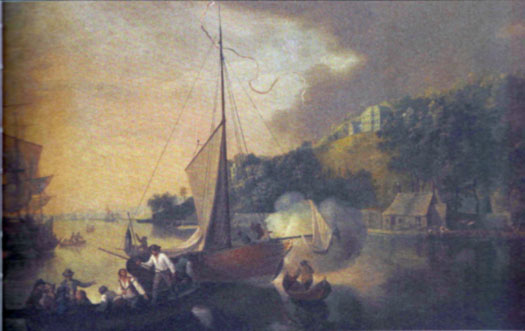 The quiet years. A lone yacht of the Water Club shown in a panting by Nathanael Grogan in the upper harbour of Cork at Tivoli in the late 18th century
The quiet years. A lone yacht of the Water Club shown in a panting by Nathanael Grogan in the upper harbour of Cork at Tivoli in the late 18th century
With each revival, names of “Old Members” would be added to the lists of new people who wished to keep the club going. And though there may have been times when Annual General Meetings weren’t held – a requirement for any club’s continuing validity today – the old Water Club always seems to have been part of the warp and weft of the great fabric of Cork Harbour, where they’d a much more relaxed attitude to the necessity for an AGM in the dim and distant past.
It became the Royal Cork Yacht Club in 1830 when sailing was being re-structured at national level, and it was always enumerated as Club No 1 in the official listings, even if the Royal Yacht Squadron tended to be listed above it. Yet if you were at the opening party of Volvo Cork Week at the Royal Cork in Crosshaven last Sunday evening, you could have been forgiven for thinking that this was a happening being organised by the newest club on the block.
The fact is the Royal Cork is not merely ageless – it is eternally young. In this era of outdoor festivals, at events like Sunday’s opening party they showed themselves ahead of the curve in having world-standard sound systems which provide a welcome and easily-audible intimacy for speakers, enabling them to put through an informative programme of crisp speeches in comfortable time as the party buzz built steadily among the gathered multitude, whose friendly attention was duly rewarded by the arrival of a sunny evening.
The atmosphere was of one great big happy family gathering. And if this seemed to be a family with many members holding high military rank with decorations to match, it’s because the occasion was taken to launch the Beaufort Cup in all its official glory, and there were more naval and other military attaches present than you’ll see at many a National Day parade.
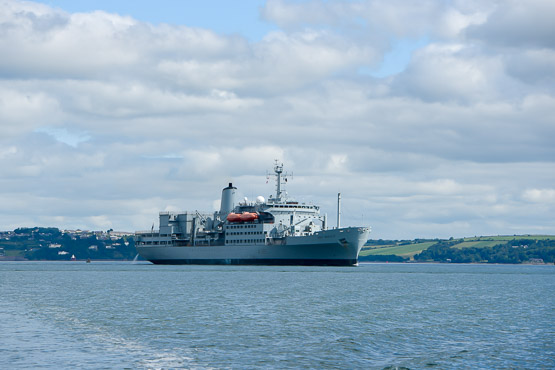 Naval presence. The successful staging of the first Beaufort Cup series within Volvo Cork Week 2016 saw increased naval activity in Cork Harbour, including this Royal Navy Supply Ship. A highlight of the Beaufort Series was a black-tie dinner for all competing crews in the Naval Base on Haulbowline Island on Tuesday night. Photo: Bob Bateman
Naval presence. The successful staging of the first Beaufort Cup series within Volvo Cork Week 2016 saw increased naval activity in Cork Harbour, including this Royal Navy Supply Ship. A highlight of the Beaufort Series was a black-tie dinner for all competing crews in the Naval Base on Haulbowline Island on Tuesday night. Photo: Bob Bateman
But far from parading military might, the Beaufort Cup is all about comradely sailing competition, providing sport afloat for people who normally look on being at sea in a very different light. And it was not just between people in the armed forces, but between agencies of all kinds – life-saving, fisheries supervision, port inspection or whatever – where I suppose the only common denominator is that at some stage the people involved might wear a uniform.
The trophy commemorates Meath-born Admiral Sir Francis Beaufort (1774-1857) whose achievements in hydrography and marine science were many. The idea of commemorating him in this way certainly captured the Volvo Cork Week imagination, with people readily making their boats available to agency crews who did not have access to craft of their own.
The spirit of it all was exemplified by the first boat and crew to the Fastnet Rock in the Beaufort’s long opening race. It was Conor Doyle of Kinsale’s X442 Freya, crewed by the Police Service of Northern Ireland. And then the overall winner of this special Fastnet race on corrected time was John Maybury of Dun Laoghaire’s champion J/109 Joker 2, sailed by an Irish Defence Forces crew skippered by Commandant Barry Byrne.
Barry Byrne and his crew on Joker 2 continued their success through the week as the varied fleet was put through a programme of equal variety, and it was singularly ironic that Class 0 in the Combined Fleets Harbour Race for the Hugh Coveney Trophy – surely the ultimate combination of a sailing come-all-ye and a festival of local knowledge – should be won by Eric de Turckheim’s A13 Teasing Machine, which is rightly recognised as one of the greatest offshore racers currently active on the planet, but arguably not a boat the smart money would have backed to win her class in a crowded race in the winding waters of Cork Harbour.
 Teasing Machine revelling in a breeze at the start of the week. Yet she won Class 0 in lighter airs in the Harbour Race. Photo: Tim Wright
Teasing Machine revelling in a breeze at the start of the week. Yet she won Class 0 in lighter airs in the Harbour Race. Photo: Tim Wright
And as for the alleged benefits of local knowledge, perhaps the Cork sailors were being just too clever in using their supposed experience in the weird ways of the tides and winds within this historic natural harbour, for the overall winner of the Harbour Race was Charlie Frieze’s Mills 36 Prime Suspect from Scotland, which made a good start in clear air, and continued to build on it.
In a sense, it was a double victory, as the breeze freshening towards the end naturally favoured the smaller boats over those already finished, despite Tony Langley’s TP52 Gladiator having zapped round the course in less than two hours. But although Prime Suspect was clearly mid-fleet in size, she put in such a neat showing she stayed ahead of Quarter Tonners and the like to take the prize.
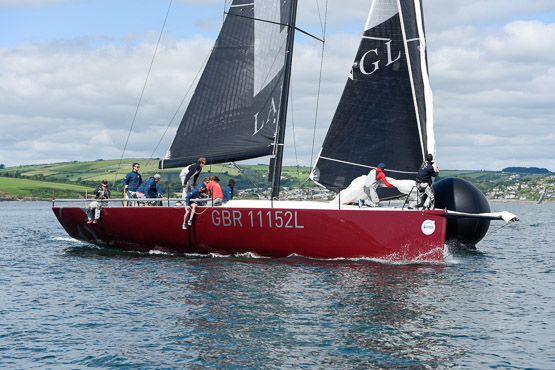 Tony Langley’s TP52 Gladiator took line honours in the Harbour Race. Photo: Bob Bateman
Tony Langley’s TP52 Gladiator took line honours in the Harbour Race. Photo: Bob Bateman
In fact, the view that smaller boats would be favoured by the freshening breeze doesn’t really stand up to examination, as second overall was taken by Richard Matthews’ new H39 Oystercatcher XXXI, a notably handsome boat in a very distinctive shade of blue. And as for assertions that an excess of local knowledge can sometimes be a drawback, Oystercatcher XXXI proved otherwise, as her crew included Eddie English who probably knows more of the sailing ways and wiles of Cork Harbour than anyone else on the planet.
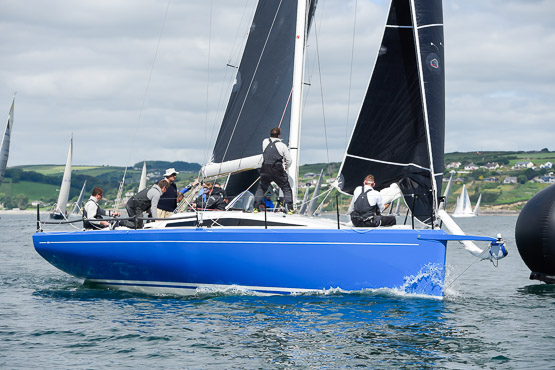 A bit of local knowledge didn’t go amiss…..with Eddie English of Cobh on board, Richard Matthews’ new Oystercatcher XXXI took second overall in the Harbour Race. Photo: Bob Bateman
A bit of local knowledge didn’t go amiss…..with Eddie English of Cobh on board, Richard Matthews’ new Oystercatcher XXXI took second overall in the Harbour Race. Photo: Bob Bateman
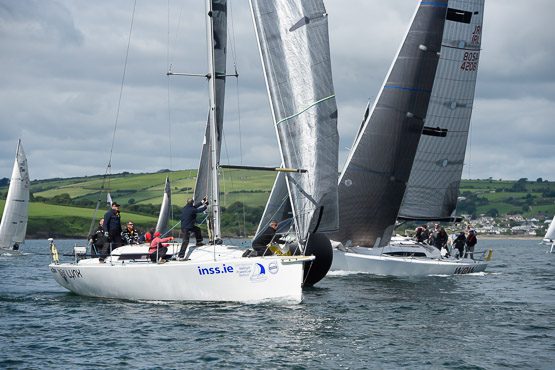 An unrivalled learning environment – the Irish National Sailing School of Dun Laoghaire’s Reflex 38 Lynx in action in Cork. Photo: Bob BatemanThird slot overall went to John Swan’s Half Tonner Harmony from Howth, continuing her dominance of Class 3 where she’d already logged six bullets in eight races by the time they took on the points-free harbour melee.
An unrivalled learning environment – the Irish National Sailing School of Dun Laoghaire’s Reflex 38 Lynx in action in Cork. Photo: Bob BatemanThird slot overall went to John Swan’s Half Tonner Harmony from Howth, continuing her dominance of Class 3 where she’d already logged six bullets in eight races by the time they took on the points-free harbour melee.
Whether sailing for fun in the Harbour Race, or competing with a real edge for points gains in races included in the European IRC Championship, there can be absolutely no doubt that this Volvo Cork Week is all about high-pitched racing, and as such is light years away from the Admiral Sailing in formation which was at the core of the sea-going activities of the Water Club in its early days.
Or is it? At mid-week I’d a very amiable discussion with Royal Cork YC archivist Dermot Burns as to whether or not the original Club of 1720 included racing in its activities. He reckons a form of competitive sailing - beyond that of showing your ability to maintain station relative to the Admiral while moving along in formation - is suggested in the Sailing Orders which were re-published in 1765 after the club had gone through one of its regenerations in 1760, though it does involve assuming that the Orders of 1765 reflected the original orders of 1720.
The many orders are un-numbered, but down around what would be number 17 we find:
“WHEN the Admiral will have the whole Fleet to Chace, he will hoist Dutch colours under his Flag, and fire a Gun from each Quarter; if a single boat, he will hoist a Pendant, and fire as many guns from the side as the Boat is distanced from him. WHEN he would have the Chace given over, he will hawl in his Flag and fire a Gun”.
Dermot’s very reasonable contention is that “Chace” is in the same sense as Steeplechasing for horses, and that these are straightforward orders for either fleet races or a match race, the start simply being made by piling on the speed from whatever position you’re in when the Admiral gives his signals.
It’s a long way from today’s precisely-laid committee boat starting lines. And it boggles the mind to think of your average modern crew trying to decide what Mr Big means when he starts firing guns from every quarter and sending all manner of flags aloft. But it’s part of the joy of studying the long history of the Royal Cork Yacht Club that such gems for interpretation come our way.
 Admiral’s orders? Former RCYC Admiral Anthony O’Leary racing top contender Antix off the Cobh waterfront. Photo: Bob Bateman
Admiral’s orders? Former RCYC Admiral Anthony O’Leary racing top contender Antix off the Cobh waterfront. Photo: Bob Bateman
And who knows, but with further tangential study it may still be possible to find out who actually won those earliest races. For though we soon find notices of a up-coming races of the Water Club being advertised in the local press, accounts of what actually happened, if they appear at all, can be confused in the extreme as the reporter is often too giddy with listing the names of the great and the good who are present, and how fashionable the gathering is, to give us the hard facts of yacht race results.
Meanwhile, Dermot was also able to put me right on the notice advertising the forthcoming Water Club Race of 1787 as entitling the winner to an Anchor. Far from being a complex right to decide where the fleet should anchor, the word is that an Anchor is a substantial measure of brandy. I should have known that.
Some histories can evoke happy memories combined with entertaining and friendly debates among friends. Such is the story of the Royal Cork Yacht Club. And with the prospect of the RCYC 300th Anniversary in 2020 coming steadily down the line, the good news is that there was across-the-board political representation at a very high level at the Crosshaven events on Sunday July 10th. So much so, indeed, that it’s reasonable to expect that whatever government is in power in 2020, there’ll be proper official support for the celebration of this unique Tricentenary for an ever-young club which could only have been founded in Ireland, and only in Cork at that.
 At last! The summer comes in from the sea at Volvo Cork Week 2016. Photo: Bob Bateman
At last! The summer comes in from the sea at Volvo Cork Week 2016. Photo: Bob Bateman



























